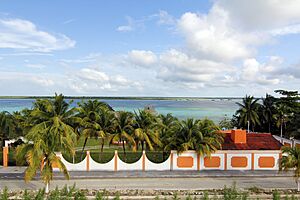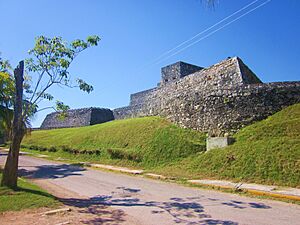Bacalar facts for kids
Bacalar is a beautiful town in Mexico. It is located in the state of Quintana Roo. This town is about 40 kilometers (25 miles) north of Chetumal. In 2010, about 11,000 people lived there. Bacalar is known for its amazing lagoon.
What's in a Name?
The name Bacalar comes from the Maya language. It probably means "surrounded by reeds." This name was used when the Spanish arrived in the 1500s. Bacalar is famous for its large, beautiful lagoon. It is often called the "Lagoon of Seven Colors." This is because its water has many different shades of blue.
A Look Back in Time
Bacalar has a long and interesting history. It was first a city of the ancient Maya civilization. The Maya founded it in 415 A.D. They called it "Sian Ka'an Bakhalal."
The Spanish explorers, called Conquistadores, arrived in the 1500s. Bacalar was the first city in this area that they were able to take over. This happened in 1543. In 1545, a Spanish leader named Gaspar Pacheco started a Spanish town here. He named it Salamanca de Bacalar.
Pirates often attacked the town in the 1600s. To protect the people, a strong fort was built. The Fortress de San Felipe Bacalar was finished in 1729. You can still visit this historic fort today.
In 1848, about 5,000 people lived in Bacalar. That same year, a big conflict called the Caste War of Yucatán began. Maya rebels took control of the town. Mexican forces took it back in 1902.
Bacalar was named a "Pueblo Mágico" in 2006. This means "Magical Town." It is a special title given to towns in Mexico. These towns have unique natural beauty, culture, or history.
See also
 In Spanish: Bacalar para niños
In Spanish: Bacalar para niños



